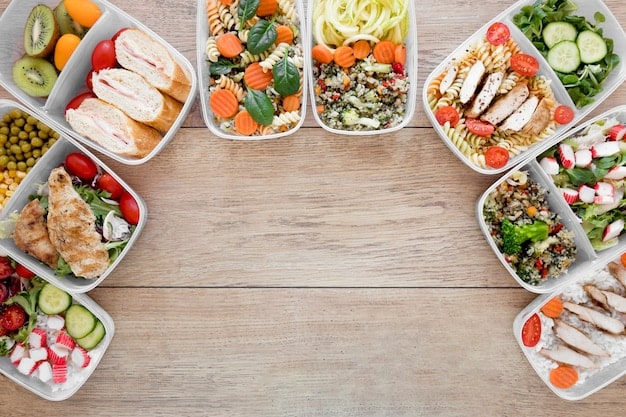Cutting Phase Nutrition: Drop 5% Body Fat in 8 Weeks

Achieving a 5% body fat reduction in 8 weeks through a cutting phase requires a meticulously planned nutritional strategy focused on a sustainable caloric deficit, precise macronutrient manipulation, and strategic food choices to preserve lean muscle mass while prioritizing fat loss.
Embarking on a journey to significantly reduce body fat requires more than just willpower; it demands a precise, science-backed approach. The concept of Cutting Phase Nutrition: How to Drop 5% Body Fat in 8 Weeks with This Plan is not merely about eating less, but about eating smarter, ensuring your body sheds fat while preserving hard-earned muscle. This guide will delve into creating a sustainable nutritional framework designed to optimize your fat loss efforts within an ambitious yet achievable 8-week timeframe.
Understanding the Cutting Phase Foundation: Caloric Deficit and Macronutrients
The cornerstone of any successful fat loss journey is the caloric deficit. This means consuming fewer calories than your body expends, forcing it to tap into stored fat reserves for energy. However, simply eating less isn’t enough; the quality and composition of those calories are paramount to ensure you’re losing fat, not muscle. A well-structured cutting phase prioritizes macronutrient balance, making sure your body receives adequate protein, healthy fats, and a controlled amount of carbohydrates.
Calculating your maintenance calories is the first, crucial step. This can be estimated using various formulas like the Mifflin-St Jeor equation, often factoring in your basal metabolic rate (BMR) and activity levels. Once maintenance is established, a deficit of 300-500 calories per day is typically recommended for gradual, sustainable fat loss. This allows for a consistent reduction without drastically impacting energy levels or muscle preservation. Rapid, aggressive deficits often backfire, leading to muscle loss and metabolic slowdowns, making the cutting journey unsustainable.
The Role of Protein in Fat Loss
Protein is arguably the most critical macronutrient during a cutting phase. It plays a pivotal role in preserving lean muscle mass, which is essential because muscle tissue is metabolically active, burning more calories even at rest. Adequate protein intake also promotes satiety, making it easier to adhere to a caloric deficit by reducing hunger pangs. Furthermore, the thermic effect of food (TEF) is highest for protein, meaning your body expends more energy digesting and metabolizing protein compared to carbohydrates or fats.
- Muscle Preservation: Protein provides the necessary amino acids to prevent muscle breakdown, especially crucial during a caloric deficit when the body might otherwise break down muscle for energy.
- Satiety: High-protein meals keep you feeling fuller for longer, reducing the likelihood of overeating or snacking on unhealthy foods.
- Increased Metabolism: The body expends more energy to digest protein, contributing to a slightly higher metabolic rate.
Aim for a protein intake of 0.8 to 1.2 grams per pound of body weight, or even higher for very lean individuals. Prioritize lean protein sources such as chicken breast, turkey, fish, lean beef, eggs, and dairy. Plant-based options like tofu, tempeh, lentils, and beans are also excellent choices.
Strategic Carbohydrate and Fat Allocation
While often vilified, carbohydrates are not the enemy in a cutting phase. They provide essential energy for workouts and daily activities, support cognitive function, and replenish glycogen stores. The key is strategic allocation. Focusing on complex carbohydrates with a high fiber content helps promote satiety and provides a steady release of energy, preventing sharp blood sugar spikes and crashes. Examples include oats, brown rice, quinoa, sweet potatoes, and whole-grain breads.
Dietary fats are equally important, despite their high caloric density. Healthy fats are crucial for hormone production, nutrient absorption, and overall cellular function. They also contribute to satiety. Focus on unsaturated fats found in avocados, nuts, seeds, olive oil, and fatty fish. Avoid trans fats and limit saturated fats. A general guideline is to derive 20-30% of your daily calories from healthy fats, carefully monitoring intake due to their high caloric value. Moderation and mindful selection are key to balancing energy needs with fat loss goals.
In summary, the foundation of your cutting phase diet rests on a manageable caloric deficit, prioritizing high-quality protein to safeguard muscle, incorporating complex carbohydrates for sustained energy, and including healthy fats for essential bodily functions. This balanced approach ensures effective fat loss without compromising health or performance.
Macronutrient Ratios and Meal Planning for Optimal Fat Loss
Once you understand the individual roles of each macronutrient, the next step is to combine them effectively into a meal plan that supports your fat loss goals. Macronutrient ratios are not a one-size-fits-all formula, but rather a flexible guideline that needs to be tailored to individual needs, activity levels, and preferences. A common starting point for a cutting phase might be around 40-50% protein, 30-40% carbohydrates, and 20-30% healthy fats, but this can be adjusted based on how your body responds.
Effective meal planning is the bedrock of consistency, which is vital for an 8-week cutting phase. This involves preparing meals in advance, portioning them correctly, and ensuring a diverse intake of nutrient-dense foods. Meal prepping eliminates guesswork, reduces the chances of impulsive, unhealthy food choices, and saves time during busy days.
Developing a Customized Macronutrient Ratio
Your ideal macronutrient ratio will depend on several factors: your current body composition, exercise intensity and frequency, and personal dietary preferences. For instance, someone engaging in intense resistance training might benefit from a slightly higher carbohydrate intake on workout days to fuel performance, while a less active individual might opt for a lower carb approach to maximize fat oxidation. Experimentation and diligent tracking are essential to find what works best for your body.
- High Protein Focus: Most cutting phases benefit from elevated protein intake to preserve muscle.
- Carbohydrate Cycling (Optional): Some individuals benefit from varying their carb intake, consuming more on workout days and fewer on rest days, to optimize energy levels and fat loss.
- Sufficient Healthy Fats: Never cut fats too low; they are critical for hormone production and satiety.
Using a food tracking app can be incredibly helpful for monitoring your caloric and macronutrient intake, providing real-time feedback and allowing you to make informed adjustments. Be patient and consistent; results accumulate over time with disciplined adherence to your plan.
Practical Meal Planning and Prep Strategies
Meal prepping doesn’t have to be complicated. Start by choosing a few staple protein sources, carbohydrate sources, and plenty of non-starchy vegetables. Cook these in bulk at the beginning of the week. For example, grill a large batch of chicken breast, cook a big pot of brown rice, and chop various vegetables like broccoli, bell peppers, and spinach.
Variety is key to preventing monotony and ensuring a wide range of micronutrients. Don’t be afraid to experiment with different seasonings, spices, and healthy sauces to keep meals exciting. Consider theme-based meal prep days (e.g., “Mexican Bowl” day, “Mediterranean Salad” day) to add flavor and diversity without increasing complexity. Portion control is also critical; invest in a food scale to accurately measure your portions, especially at the beginning of your cutting phase, until you develop an intuitive understanding of appropriate serving sizes.

Think about how your meals will fit into your daily schedule. For some, three balanced meals with a couple of small snacks work best. Others prefer more frequent, smaller meals. The total daily intake and macronutrient distribution matter more than the number of meals. Consistency in eating times can also help regulate appetite and metabolic rhythm. A well-executed meal plan is a powerful tool for achieving your 8-week fat loss goal, turning abstract nutritional guidelines into tangible, edible progress.
By meticulously planning your macronutrient ratios and dedicating time to meal preparation, you lay a solid groundwork for success in your cutting phase. This systematic approach tackles the challenges of hunger management and nutritional adequacy, making the journey toward 5% body fat reduction significantly more manageable and effective.
Optimizing Food Choices: Nutrient Density and Satiety
Beyond macronutrient ratios, the specific foods you choose play a crucial role in the success of your cutting phase. Opting for nutrient-dense foods means getting the maximum amount of vitamins, minerals, and other beneficial compounds for the fewest calories. These foods are generally high in fiber and water content, which significantly contributes to satiety, helping you feel full and satisfied on fewer calories. This strategy is essential for managing hunger, a common challenge when in a caloric deficit.
Prioritizing whole, unprocessed foods should be a mantra during your cutting phase. These foods not only offer superior nutritional value but also naturally contain compounds that support metabolic health and overall well-being. Avoiding processed foods, sugary drinks, and excessive amounts of unhealthy fats helps eliminate empty calories that offer little to no nutritional benefit and often lead to increased hunger.
High-Satiety Food Sources
When you’re trying to reduce body fat, managing hunger is paramount. Certain foods excel at keeping you feeling full, which is a major advantage for adherence to your diet plan. Foods high in protein and fiber are your best allies in this regard. Lean proteins like chicken breast, turkey, fish, and Greek yogurt have a high satiety index, meaning they keep hunger at bay for longer periods.
- Lean Proteins: Chicken, turkey, fish (salmon, cod, tuna), lean beef cuts, eggs.
- High-Fiber Vegetables: Broccoli, spinach, kale, bell peppers, Brussels sprouts, asparagus.
- Legumes: Lentils, chickpeas, black beans (excellent source of both protein and fiber).
- Whole Grains: Oats, quinoa, brown rice (in controlled portions due to carbohydrate content).
- Fruits: Berries, apples, pears (high in fiber and natural sugars, but consume in moderation).
Incorporating a large volume of non-starchy vegetables into every meal is a simple yet effective strategy. They provide bulk, fiber, and micronutrients with minimal calories, making your plates look fuller and more satisfying without increasing your caloric load significantly. This helps psychologically and physically.
Hydration and Its Impact on Hunger and Metabolism
Often overlooked, adequate hydration is a critical component of any fat loss strategy. Water not only supports essential bodily functions but also plays a significant role in managing hunger. Sometimes, the body confuses thirst signals with hunger, leading to unnecessary snacking. Drinking plenty of water throughout the day can help differentiate between actual hunger and dehydration.
Aim for at least 8-10 glasses (around 2-3 liters) of water daily. You can also incorporate calorie-free beverages like unsweetened tea, black coffee, or sparkling water with a squeeze of lemon or lime. Beyond hunger management, water is vital for metabolic processes, nutrient transport, and regulating body temperature, all of which are important for an effective cutting phase. Beginning your day with a large glass of water and drinking water before each meal can be powerful habits for curbing appetite and improving digestion. Furthermore, consuming adequate water also helps with the excretion of waste products and maintaining electrolyte balance, which can be affected during periods of increased physical activity and dietary changes.
By consciously selecting nutrient-dense, high-satiety foods and maintaining optimal hydration, you create a powerful synergy that supports your caloric deficit while minimizing discomfort and maximizing nutritional intake. This smart approach to food choices makes the 8-week cutting phase not only more effective but also more enjoyable and sustainable.
Strategic Supplementation and Practical Tips for Adherence
While diet and exercise are the primary drivers of fat loss, certain supplements can play a supportive role in a cutting phase, helping to optimize performance, preserve muscle, and manage appetite. However, it’s crucial to remember that supplements are just that—supplements. They enhance, not replace, a solid nutritional foundation. Beyond supplements, practical strategies for staying consistent and a strong understanding of what to expect are vital for hitting your 8-week goal.
The supplement market is vast and often confusing, filled with products making grand claims. Focusing on evidence-based supplements that genuinely support your goals is key. Furthermore, developing robust habits and coping mechanisms for potential challenges like diet fatigue or cravings will significantly improve your chances of success.
Evidence-Based Supplements to Consider
For a cutting phase, the primary goal of supplementation is to aid muscle preservation and support fat metabolism. Here are a few commonly recommended supplements that have research backing their efficacy:
- Whey Protein: Excellent for muscle protein synthesis, particularly post-workout. It’s a convenient way to meet your protein targets, especially when whole food options aren’t readily available.
- Creatine Monohydrate: While often associated with bulking, creatine helps maintain strength and power output during a caloric deficit, indirectly aiding muscle preservation by allowing you to train harder.
- BCAAs (Branched-Chain Amino Acids): Some studies suggest BCAAs may help reduce muscle breakdown during intense training in a fasted state, though a high overall protein intake often negates the need for isolated BCAAs.
- Caffeine: A well-known stimulant that can boost energy levels, enhance focus, and slightly increase metabolic rate, which can be beneficial during periods of lower energy on a deficit.
- Omega-3 Fatty Acids: Found in fish oil, omega-3s possess anti-inflammatory properties, promote overall health, and may indirectly support fat loss by improving insulin sensitivity.
Always consult with a healthcare professional or a registered dietitian before incorporating any new supplements into your regimen, especially if you have underlying health conditions or are taking medications. Quality and dosage are critical when selecting supplements; opt for reputable brands with third-party testing.
Managing Expectations and Overcoming Plateaus
Fat loss is rarely a linear process. You will likely encounter plateaus, where your weight loss stalls despite consistent effort. This is a normal physiological adaptation as your body adjusts to the caloric deficit. When this happens, avoid drastically cutting more calories. Instead, consider methods like re-feeds (planned days of higher carbohydrate intake) or diet breaks (a week or two at maintenance calories) to reset your metabolism and psychological well-being. Tracking progress beyond the scale is also crucial; body measurements, progress photos, and how your clothes fit can offer a more accurate picture of fat loss and muscle preservation.

Adherence is king. Diet fatigue and cravings are inevitable. Develop strategies to cope: plan for “flex meals” (small, controlled indulgences that fit your macros), engage in stress-reducing activities, and ensure adequate sleep. Poor sleep can disrupt hunger hormones, making adherence more challenging. Remembering your “why” – the motivation behind your 5% body fat goal – can also be a powerful tool to push through difficult moments.
By approaching supplementation mindfully and equipping yourself with practical strategies for managing the ups and downs of a cutting phase, you transform potential obstacles into manageable challenges. This holistic strategy empowers you to maintain consistency and successfully navigate the 8-week journey to a leaner physique.
Beyond Nutrition: The Synergy of Training and Recovery for Fat Loss
While nutrition forms the bedrock of a successful cutting phase, its effectiveness is profoundly amplified when integrated with a smart training regimen and adequate recovery. Focusing solely on diet, without considering exercise and rest, won’t yield optimal results in terms of body composition. To achieve a 5% body fat reduction in 8 weeks, it’s crucial to understand how resistance training, cardiovascular exercise, and recovery work in harmony to maximize fat loss and preserve lean muscle mass.
The goal is not just to lose weight, but to lose fat specifically, while maintaining or even improving muscle definition. This requires a strategic approach to physical activity, ensuring that your workouts are challenging enough to stimulate muscle and burn calories, but not so intense that they hinder recovery or lead to overtraining, especially in a caloric deficit.
Resistance Training: The Muscle Preservation Engine
Resistance training is non-negotiable during a cutting phase. Its primary role is to signal to your body that muscle tissue is still needed and should be preserved, even when calories are restricted. Without sufficient resistance training, your body is more likely to break down muscle for energy along with fat, leading to a “skinny fat” appearance and a slower metabolism.
- Maintain Intensity: Focus on maintaining your strength and performance, rather than constantly trying to hit new personal bests. Continue to lift heavy weights with proper form.
- Compound Movements: Prioritize exercises that work multiple muscle groups simultaneously (e.g., squats, deadlifts, bench press, rows, overhead press) to maximize calorie expenditure and muscle activation.
- Volume Adjustment: You might need to slightly reduce training volume (sets/reps) as calorie intake decreases to aid recovery, but maintain intensity.
Aim for 3-4 resistance training sessions per week, allowing for adequate rest between sessions. This approach not only burns calories during the workout but also boosts your metabolism for hours afterward through the “afterburn effect” (EPOC – Excess Post-exercise Oxygen Consumption) and by maintaining muscle mass, which has a higher metabolic rate than fat tissue.
Cardiovascular Exercise: Fat-Burning Catalyst
Cardio complements resistance training by directly increasing caloric expenditure, further deepening your caloric deficit without extreme dietary restrictions. There are different types of cardiovascular exercise, each offering unique benefits for fat loss.
Low-Intensity Steady State (LISS) cardio: Such as brisk walking, light cycling, or elliptical training, is excellent for burning fat without overly taxing the central nervous system, making it ideal for recovery days or as a supplemental activity. It’s sustainable and has minimal impact on muscle soreness.
High-Intensity Interval Training (HIIT): Involves short bursts of intense exercise followed by brief recovery periods. HIIT is very effective for burning a significant number of calories in a shorter amount of time and can elevate your metabolism post-workout. However, it’s more demanding and should be used judiciously, perhaps 1-2 times per week, to avoid burnout or overtraining.
The best cardio approach is often a mix of both, tailored to your energy levels and recovery capacity. Listen to your body and adjust as needed. Often, people begin their cutting phase with more LISS and introduce HIIT as their fitness improves and their body adapts to the caloric deficit.
The Non-Negotiable Role of Recovery and Sleep
Recovery is where adaptation happens. Without adequate rest and sleep, your body cannot repair muscle tissue, regulate hormones effectively, or manage stress efficiently. In a caloric deficit, where the body is already under more stress, recovery becomes even more critical. Poor sleep can elevate cortisol levels (a stress hormone that can promote fat storage and muscle breakdown) and negatively impact hunger-regulating hormones like leptin and ghrelin, making cravings harder to control.
Aim for 7-9 hours of quality sleep per night. Establish a consistent sleep schedule, create a relaxing bedtime routine, and minimize exposure to screens before bed. Beyond sleep, incorporating active recovery days (light activity like walking or stretching) and managing overall stress levels through practices like meditation or mindfulness are equally important. A well-rested body is more efficient at burning fat, preserving muscle, and performing optimally during workouts.
By strategically combining resistance training to preserve precious muscle, targeted cardio to accelerate fat loss, and prioritizing recovery and sleep, you create a powerful holistic approach to achieving your 5% body fat reduction goal within the 8-week timeframe. This synergy is what truly transforms your body composition, moving beyond simple weight loss to genuine body recomposition.
Monitoring Progress and Adapting Your Strategy
Successfully dropping 5% body fat in 8 weeks is a dynamic process that requires consistent monitoring and intelligent adaptation. It’s rarely a ‘set it and forget it’ situation. Your body will adapt to the caloric deficit, and your metabolism might slow down. Therefore, regularly tracking your progress and being prepared to make adjustments to your nutrition and training plan is critical. This feedback loop ensures you stay on track and overcome inevitable plateaus.
Reliance on just one metric, like scale weight, can be misleading. A holistic approach to progress tracking provides a more accurate picture of body composition changes. Understanding when and how to adjust your intake or activity levels is key to continuous progress throughout the 8-week period.
Multifaceted Progress Tracking
The scale can be a useful tool, but it doesn’t tell the whole story, especially when you’re focusing on body fat loss while preserving muscle. Muscle is denser than fat, so your weight might not drop as dramatically as expected, even if your body composition is improving. Incorporate these additional methods for a comprehensive view:
- Body Measurements: Use a tape measure to track changes in circumference around your waist, hips, chest, and arms. These often reveal fat loss even if the scale doesn’t move.
- Progress Photos: Take weekly or bi-weekly photos (front, side, back) in the same lighting and attire. Visual changes are highly motivating and can reveal subtle recomp.
- Performance in the Gym: Are you maintaining strength? Are your reps still solid? Maintaining or improving performance indicates muscle preservation.
- How Clothes Fit: This is an incredibly practical and often overlooked indicator. Clothes fitting looser, especially around the waist, is a clear sign of fat loss.
- Body Fat Testing: If accessible, professional body fat measurements (e.g., DEXA, calipers, BIA) can provide a more precise tracking of body fat percentage changes.
Consistency in tracking is important. Take measurements at the same time of day and under similar conditions to ensure accuracy. For example, weigh yourself first thing in the morning after using the restroom, before consuming anything.
Responding to Plateaus and Adapting the Plan
A plateau occurs when your fat loss stalls for two consecutive weeks despite strict adherence to your plan. This is a sign that your body has adapted and your current caloric deficit is no longer sufficient to stimulate further fat loss. When this happens, several strategies can be employed:
Slight Calorie Adjustment: Reduce your daily caloric intake by another 100-200 calories. This can be done by slightly reducing carbohydrate or fat intake, but avoid going too low, which can impact energy and muscle. This small adjustment can often kickstart fat loss again without putting too much stress on the body. Be mindful not to drastically cut calories, as this can lead to nutrient deficiencies and metabolic downregulation.
Increase Activity: Add an extra short cardio session, or increase the duration or intensity of your existing workouts. Even small increases in Non-Exercise Activity Thermogenesis (NEAT), such as taking the stairs or walking more, can make a difference. Incorporating more steps into your daily routine is a highly sustainable way to incrementally increase your energy expenditure. This can include walking to work, taking regular breaks to move around, or standing while working.
Re-feeds or Diet Breaks: As mentioned earlier, strategic re-feeds (one day of higher carb/calorie intake) or full diet breaks (a week at maintenance calories) can help recalibrate hormones, reduce diet fatigue, and boost metabolism. These are not cheat days; they are strategic elements of a longer-term plan designed to optimize metabolic function and adherence. Re-feeds can replenish glycogen stores, which can improve workout performance and muscular fullness, while diet breaks provide a psychological break from the continuous deficit.
Prioritize Sleep and Stress Management: Persistent plateaus can also be a sign of inadequate recovery or high stress levels, both of which can impact hormones regulating fat loss. Double down on sleep quality and stress-reduction techniques. Recognizing the intricate connection between mental well-being and physical outcomes is crucial for sustained progress.
By adopting a flexible and responsive approach to your cutting phase, you empower yourself to navigate the challenges, make informed decisions, and ultimately achieve your goal of dropping 5% body fat in 8 weeks. This iterative process of tracking, analyzing, and adapting is the hallmark of successful body transformation.
| Key Aspect | Brief Description |
|---|---|
| 📊 Caloric Deficit | Essential for fat loss, aim for 300-500 kcal reduction from maintenance. |
| 🥩 High Protein | Crucial for muscle preservation and satiety; 0.8-1.2g/lb body weight. |
| 🥦 Nutrient Density | Prioritize whole, unprocessed foods high in fiber and micronutrients. |
| 🏋️ Synergy | Combine nutrition with resistance training and adequate rest for best results. |
Frequently Asked Questions
▼
Achieving a 5% body fat drop in 8 weeks is ambitious but realistic for many, particularly those with a higher starting body fat percentage. It requires strict adherence to a caloric deficit, consistent exercise (including resistance training), and proper recovery. Individual results vary based on metabolism, consistency, and starting point.
▼
Common pitfalls include an overly aggressive caloric deficit leading to muscle loss, inadequate protein intake, neglecting healthy fats, insufficient sleep, and inconsistent training. Emotional eating, lack of meal prep, and giving in to frequent cravings can also derail progress. Patience and a sustainable approach are key.
▼
While building significant muscle is challenging in a caloric deficit, “body recomposition” (losing fat while gaining muscle) is possible, especially for beginners or those returning to training. For most, the goal is muscle preservation. High protein intake and consistent resistance training are vital for this specific objective.
▼
Aim for at least 8-10 glasses (approximately 2-3 liters) of water daily. Hydration is crucial for metabolic functions, appetite suppression (often thirst is mistaken for hunger), and overall physical performance during workouts. Adjust intake based on activity level, climate, and individual needs to ensure optimal hydration throughout the day.
▼
If you hit a plateau (no progress for 1-2 weeks), first ensure strict adherence. Then, consider a slight caloric reduction (100-200 calories), increasing non-exercise activity, or integrating a re-feed day. Sometimes, a short diet break at maintenance calories can also help reset your metabolism and psychological state for renewed progress.
Conclusion
Achieving a 5% body fat reduction in just 8 weeks is an intensive but attainable goal that hinges on a meticulously structured and consistently executed plan. It demands more than just casual effort; it requires a deep understanding of caloric deficit, precise macronutrient manipulation, and intelligent food choices that prioritize nutrient density and satiety. Beyond the plate, the synergy of a disciplined resistance training regimen, strategic cardiovascular exercise, and adequate recovery is indispensable. By embracing a holistic approach, diligently monitoring progress through various metrics, and being prepared to adapt your strategy as your body responds, you position yourself for success. This journey is a testament to the power of consistency, informed decisions, and a commitment to transforming your physique in a sustainable and healthy manner.





